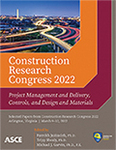Prediction of Egypt’s Construction Industry Resilience
Publication: Construction Research Congress 2022
ABSTRACT
The Covid-19 pandemic has affected industries globally: many have regressed due to stoppages, others have flourished, while some have remained dormant. The construction industry’s nature as “labor intensive” has forced some governments to allow its continuation through lockdowns and unstable times. Overall economic conditions can be explained through macroeconomic indicators as CPI, PPI, stock market indices, and unemployment rate. Construction industry’s output can be interpreted from indicators as the country’s GDP from construction. In Egypt, while Covid-19 impact has hit the economy, the overall GDP growth rate has dropped for the first time in nine years from 5% to –1.7%, while the GDP from construction has not been significantly affected presenting high resiliency. This research aims to propose a neural networks model to predict construction industry’s resilience, explained through GDP from construction, using lagged macroeconomic indicators as predictors. Granger causality test is utilized to identify which macroeconomic indicators can be the leading indicators of the GDP from construction up to three quarters ahead. Data in Egypt from June 2008 to December 2020 are used as the study domain. Results show that although long term correlation exists, construction industry in Egypt can be classified as a resilient one. Such an approach can be applied on global markets providing the ability to predict resilience of an industry during economic shocks and unstable times, which would better prepare governments, investors, and shareholders.
Get full access to this article
View all available purchase options and get full access to this chapter.
REFERENCES
Ashuri, B., Shahandashti, S. M., and Lu, J. (2012). Empirical tests for identifying leading indicators of ENR Construction Cost Index. Construction Management and Economics, 30(11), 917–927. https://doi.org/10.1080/01446193.2012.728709.
Cao, M.-T., Cheng, M.-Y., and Wu, Y.-W. (2015). Hybrid Computational Model for Forecasting Taiwan Construction Cost Index. Journal of Construction Engineering and Management, 141(4), 04014089. https://doi.org/10.1061/(ASCE)CO.1943-7862.0000948.
Cao, Y., and Ashuri, B. (2020). Predicting the Volatility of Highway Construction Cost Index Using Long Short-Term Memory. Journal of Management in Engineering, 36(4), 04020020. https://doi.org/10.1061/(ASCE)ME.1943-5479.0000784.
Choi, C.-Y., Ryu, K. R., and Shahandashti, M. (2021). Predicting City-Level Construction Cost Index Using Linear Forecasting Models. Journal of Construction Engineering and Management, 147(2), 04020158. https://doi.org/10.1061/(ASCE)CO.1943-7862.0001973.
Crosthwaite, D. (2000). The global construction market: A cross-sectional analysis. Construction Management and Economics, 18(5), 619–627. https://doi.org/10.1080/014461900407428.
International Monetary Fund. (2020). A long and difficult ascent.
Jiang, H., and Liu, C. (2011). Forecasting construction demand: A vector error correction model with dummy variables. Construction Management and Economics, 29(9), 969–979. https://doi.org/10.1080/01446193.2011.611522.
Oshodi, O., Ejohwomu, O. A., Famakin, I. O., and Cortez, P. (2017). Comparing univariate techniques for tender price index forecasting: Box-Jenkins and neural network model. Construction Economics and Building, 17(3), 109–123. https://doi.org/10.5130/AJCEB.v17i3.5524.
Shiha, A., Dorra, E. M., and Nassar, K. (2020). Neural Networks Model for Prediction of Construction Material Prices in Egypt Using Macroeconomic Indicators. Journal of Construction Engineering and Management, 146(3), 04020010. https://doi.org/10.1061/(ASCE)CO.1943-7862.0001785.
Thomas Ng, S., Cheung, S. O., Martin Skitmore, R., Lam, K. C., and Wong, L. Y. (2000). Prediction of tender price index directional changes. Construction Management and Economics, 18(7), 843–852. https://doi.org/10.1080/014461900433122.
Thomas Ng, S., Fan, R. Y. C., and Wong, J. M. W. (2011). An econometric model for forecasting private construction investment in Hong Kong. Construction Management and Economics, 29(5), 519–534. https://doi.org/10.1080/01446193.2011.570356.
Wong, J. M. W., Chiang, Y. H., and Ng, T. S. (2008). Construction and economic development: The case of Hong Kong. Construction Management and Economics, 26(8), 815–826. https://doi.org/10.1080/01446190802189927.
Yiu, C. Y., Lu, X. H., Leung, M. Y., and Jin, W. X. (2004). A longitudinal analysis on the relationship between construction output and GDP in Hong Kong. Construction Management and Economics, 22(4), 339–345. https://doi.org/10.1080/0144619042000176465.
Information & Authors
Information
Published In
History
Published online: Mar 7, 2022
Authors
Metrics & Citations
Metrics
Citations
Download citation
If you have the appropriate software installed, you can download article citation data to the citation manager of your choice. Simply select your manager software from the list below and click Download.
